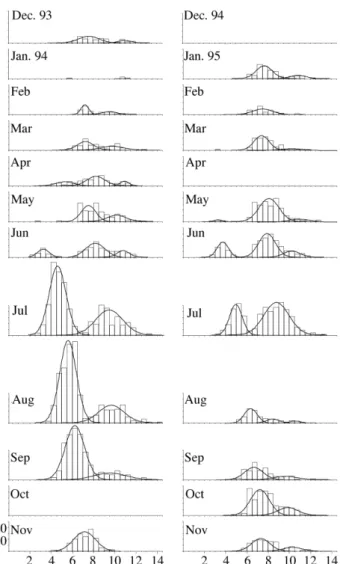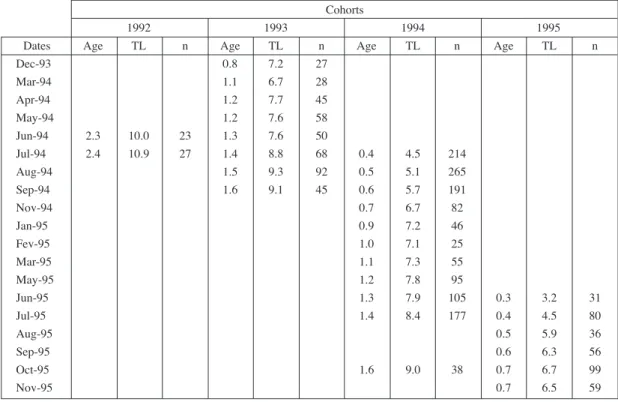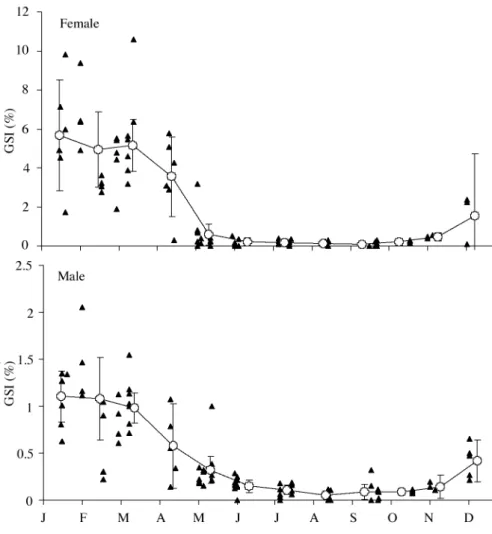OF THE RED BLENNY PARABLENNIUS RUBER (BLENNIIDAE)
by
José Manuel N. AZEVEDO (1) & Nídia HOMEM
ABSTRACT. - Basic biological information for a sublittoral population of the red blenny Parablennius ruber is presented based on a two-year study involving 2350 specimens. The length-weight relationship was given by TW = 0.011 x TL2.963
(where TW = total weight, in g; TL = total length, in cm). Age at length data was inferred by modal analysis of the monthly length-frequency distributions. The parameters of the fitted von Bertalanffy growth equation (with seasonal component, birth date on February, 15th) were L∞ = 13.22 cm; K = 0.62 year-1; to = -0.39 year; C = 0.68; WP = 0.97.
Macroscopic examination of the gonads, and analysis of the monthly values of the gonadosomatic index, indicated that reproduction occurs in winter, with a maximum in February and March, when water temperatures are low. Individuals become sexually mature around 6 cm TL, a size that can be reached in less than one year. Stomach contents suggest an omnivorous diet mainly composed of scrapped filamentous algae and associated invertebrates.
RÉSUMÉ. - Âge, croissance, reproduction et régime alimentaire de la blennie rouge, Parablennius ruber (Blenniidae). Les principaux paramètres biologiques d’une population sublittorale de la blennie rouge, Parablennius ruber sont présentés, à partir d’une étude de deux ans et 2350 exemplaires. La relation taille-poids est de TW = 0,011 x TL2,963 (où
TW = poids total, en g ; TL = longueur totale, en cm). La courbe de croissance a été déduite à partir de l’analyse modale des fréquences mensuelles de distributions des fréquences de taille. Les paramètres de l’équation de von Bertalanffy (avec une composante saisonnière et date de naissance le 15 février) sont : L∞ = 13,22 cm ; K = 0,62 année-1 ; to=-0,39 année ;
C = 0,68 ; WP = 0,97. L’examen macroscopique des gonades et l’analyse des valeurs mensuelles de l’indice gonadoso-matique indiquent que la reproduction a lieu en hiver, avec un maximum en février et mars quand la température de l’eau est la plus basse. Les individus deviennent sexuellement mûrs à environ 6 cm TL, une taille qui peut être atteinte en moins d’une année. Les contenus stomacaux suggèrent un régime alimentaire omnivore d’algues filamenteuses avec les inverté-brés associés.
Key words. - Blenniidae - Parablennius ruber - Biology - Length-weight relationship - Length-frequency distributions - Modal analysis.
Parablennius ruber is a little studied blenny. Being mor-phologically similar to P. gattorugine, its validity as a sepa-rate species was confirmed only recently (Almeida, 1982; Bath, 1982). Because of this, its geographical distribution is still uncertain. It occurs in the Azores and Madeira and in sympatry with P. gattorugine in the Portuguese mainland (Almeida, 1982; Oliveira et al., 1992). But the oldest records (including the species description) are from the Atlantic coast of France (Valenciennes in Cuvier and Valenciennes, 1836; Moreau, 1881, 1892), so it is likely to have a wider distribution than that suggested by the com-mon name. Santos et al. (1997) have coined for it, Portuguese blenny.
Information regarding the biology and/or ecology of this species is restricted to the observations of Almeida and Harmelin-Vivien (1983) on subtidal animals, and of Santos (1987), on tidal pools. This paper results from an investiga-tion into the biology and ecology of the marine littoral fishes of the Azores, and gives the first comprehensive data on the abundance, age and growth, food and reproduction of this species.
(1) Departamento de Biologia, Universidade dos Açores, Rua Mãe de Deus, 9500 Ponta Delgada, PORTUGAL. [azevedo@notes.uac.pt]
MATERIAL AND METHODS
Between December 1993 and November 1995, 2350 specimens (2.4 to 14.1 cm TL) were captured at 3-5 m depth on a rocky reef near Ponta Delgada harbour, on the island of São Miguel, Azores. One to three samples were taken each month (4-357 animals per month, average 112) by SCUBA diving, using rotenone. Each sample was taken in the mor-ning, using the same amount of rotenone spread in an area of about 100 m2.
Specimens were measured (total length, TL, to the nea-rest mm below), weighed (total wet weight, WT, in g), fixed
in 15% buffered formalin and transferred to 70% ethanol after 2-4 weeks. Later, a monthly sub-sample of one male and one female per size class of 1 cm was selected, out of 199 specimens. Sex was determined by external examina-tion of the anal fin morphology, following Smith (1974) and Zander (1975), and confirmed by macroscopic observation of the gonads, which were removed and weighed (gonad weight, WG, in g). Gonad weighing was not generally
index (IG) was calculated as IG =WG / (WT - WG) * 100. A
total of 28 stomachs, from up to 5 specimens of each sex and season, selected to cover the entire size range present, were removed, weighed (WS), and placed in 70% ethanol.
Since the stomach contents consisted of finely divided par-ticles of approximately the same volume, it was spread on a single layer on Petri dishes containing a central grid of 6x6 squares. The food items located on each of the 36 squares was identified to the lowest possible taxonomic rank and noted. Results are presented as (i) percentage occurrence in the stomachs (%O, number of stomachs with item over total number of stomach contents examined) and (ii) percentage volume (%V, average number of counts over total number of counts). Individual stomach fullness was assessed as a percentage of the maximum WS/WT observed.
Age at length data were deduced from modal analysis of the monthly length-frequency distributions and used to cal-culate the parameters of the von Bertalanffy seasonalized growth equation, following the methods described in Sparre and Venema (1992) and using the FiSAT software (Gayanillo et al., 1994). February 15, at the peak of the reproductive season (see chapter Results), was chosen as the birth date.
RESULTS Age and growth
The largest animal captured had 14.1 cm TL, and more than 20% of all the fishes of the present study exceeded the maximum length previously known (9 cm, Zander, 1986).
The monthly length-frequency distributions, and respec-tive modal analysis, are given in figure 1. Both sexes were considered together. Several well-defined modes can be seen and a displacement to the right followed between suc-cessive months. These modes were assumed to correspond to distinct age groups, or cohorts. Young of the year form a visible cohort in June of both years, and the 1994 cohort can be traced up to July the following year. The 1993 and 1992 cohorts were deduced by comparison. Based on these pre-mises, an age-length key was computed (Tab. I). This key contains enough age-length points to allow the adjustment of a von Bertalanffy growth curve with a seasonal compo-nent (Fig. 2). The parameters obtained were:
L∞ = 13.22 cm; K = 0.62 year-1; t0 = -0.39 year;
C = 0.68; WP = 0.97
The length-weight relationship is given by WT = 0.011 * TL2.963 (r = 0.985, n = 359)
Reproduction
Monthly changes in gonadosomatic index (IG) for each
sex (both years combined) are shown in figure 3. For both sexes highest values were observed in winter, from January
to March, being very low throughout the summer and fall. Females with ripe gonads (oocytes extruding under light pressure on the abdomen) were observed in the months with the highest IG.
Mature gonads were found only in specimens with total
Figure 1. - Monthly length-frequency distributions of Parablen-nius ruber, with superimposed normal curves from modal analy-sis.
Figure 2. - Adjustment of the calculated growth curves to the age-length values obtained by modal analysis. See text for curve para-meters.
length equal to or greater than 6 cm. This is assumed to represent the size at first sexual maturation for this popula-tion. According to the growth equation calculated above, individuals can reach sexual maturity in the reproductive season immediately following the one in which they were born.
Food
Table II shows the percentage occurrence and volume of different food items in red blenny stomachs. Three items were dominant in terms of volume: red algae, sponges and amphipods. Most stomachs also contained gastropods and isopods, but with much smaller volumes. This indicates an omnivorous, grazing, diet. The main algae observed were components of the shallow sublittoral algal turf, such as Ceramium, Chondrachanthus, Corallina, and Amphiroa. Small algal volumes (0 to 10%) were only found in the smaller specimens (TL ≤ 8 cm).
DISCUSSION
The growth equation deduced in the present study helps to reconcile apparently opposed behavioural observations by previous authors. Santos (1987) noted that Parablennius ruber is a territorial species, even outside the reproduction period. However, Almeida (1982) observed up to 15
indivi-duals sharing the same shelter. Santos (1987) also observed instances of less differentiated socio-spatial contact but only between juveniles, and suggests that this is the case of Almeida’s observations. In fact, Almeida and Harmelin-Vivien (1983) mentioned that the individuals in those groups had between 3.5 and 9 cm. According to the present data, this is the size range of the 0+ cohort in July and August, when those authors worked.
The reproductive season now determined is consistent with but slightly earlier than that recorded by Santos (1987). That the average 0+ individual is capable of reproducing
Cohorts
1992 1993 1994 1995
Dates Age TL n Age TL n Age TL n Age TL n
Dec-93 0.8 7.2 27 Mar-94 1.1 6.7 28 Apr-94 1.2 7.7 45 May-94 1.2 7.6 58 Jun-94 2.3 10.0 23 1.3 7.6 50 Jul-94 2.4 10.9 27 1.4 8.8 68 0.4 4.5 214 Aug-94 1.5 9.3 92 0.5 5.1 265 Sep-94 1.6 9.1 45 0.6 5.7 191 Nov-94 0.7 6.7 82 Jan-95 0.9 7.2 46 Fev-95 1.0 7.1 25 Mar-95 1.1 7.3 55 May-95 1.2 7.8 95 Jun-95 1.3 7.9 105 0.3 3.2 31 Jul-95 1.4 8.4 177 0.4 4.5 80 Aug-95 0.5 5.9 36 Sep-95 0.6 6.3 56 Oct-95 1.6 9.0 38 0.7 6.7 99 Nov-95 0.7 6.5 59
Table I. - Age-length key for Parablennius ruber, based on modal analysis data. Age in years, TL in cm.
Number of stomachs: 28
Mean fullness (± std. dev.): 57 ± 21% Items %O %V Algae Rhodophyta 82 24 Other 11 1 Porifera 86 27 Hydrozoa 50 8 Polychaeta 4 0 Mollusca Bivalvia 14 1 Gastropoda 61 4 Crustacea Isopoda 64 7 Amphipoda 93 28 Unidentified 54 3
Table II. - Stomach contents of Parablennius ruber: percentage occurrence (%O) and average percentage volume (%V) of the main taxonomic groups of items.
was not previously known. The closely related P. gattoru-gine becomes sexually mature only at one year of age, in Galway Bay, Ireland (Dunne and Byrne, 1979). A similar situation has been described for other small littoral fishes of the Azores. Azevedo and Simas (2000), for instance, have determined that specimens from the Azorean population of Gobius paganellus are reproductively mature in their first year of life, in contrast with the equivalent populations of northern Europe, where individuals take up to 3 years to reach sexual maturity. This precocious growth was linked to the higher seawater temperatures in the Azores.
There is some disagreement between the current data and the observations of Santos (1987) regarding the diet of P. ruber. This author has stated that this is an active preda-tor, searching and capturing a variety of small benthic inver-tebrates, such as amphipods, polychaetes, bryozoans, iso-pods and gastroiso-pods. The presence of algae in the stomach contents examined by this author is reduced to small frag-ments of Corallina. This contrasts with the result of the present study that algae constitute a major part of most
sto-mach contents, being found in such volumes that its pre-sence is hardly accidental. A similar situation is found in the literature. Goldschmidt and Kotrschal (1981) studied three populations of Blennius incognitus and classified this spe-cies as an omnivorous unselective “Aufwuchs” grazer. In previous works, however, the same species had been classi-fied as a facultative omnivorous (Zander and Bartsch, 1972) or even as carnivorous (Gibson, 1969). Obviously a high degree of plasticity in food choice is involved in both cases. Goldschmidt and Kotrschal (1981) have linked the increased amount of algae in the stomachs with the decrease of availa-ble animal food that could be preyed selectively. The ani-mals would then resort to scrapping off the substratum to ingest the associated fauna.
Acknowledgments. - The first author wishes to thank the many students of the Departamento de Biologia, Universidade dos Açores, who helped with the field work. We also appreciated the valuable comments of the two anonymous referees.
Figure 3. - Gonadosomatic index for each sex of Parablennius ruber: indi-vidual values (triangles) and monthly averages ± 95% confidence interval (circles and error bars). Note different scales on the GSI axes of each graph.
REFERENCES
ALMEIDA A.J., 1982. - Sur la présence de Blennius ruber Valenciennes, 1836 aux Açores (Pisces, Blenniidae). Cybium, 6(2): 35-40.
ALMEIDA A.J. & M. HARMELIN-VIVIEN, 1983. - Quelques notes sur des Blenniidés observés et capturés aux Açores en 1979 (Pisces: Blenniidae). Cybium, 7(1): 39-45.
AZEVEDO J.M.N. & A.M.V. SIMAS, 2000. - Age and growth, reproduction and diet of a sublittoral population of the rock goby Gobius paganellus (Teleostei: Gobiidae). Hydrobiologia, 440: 129-135.
BATH H., 1982. - Beitrag zur Revalidation von Parablennius ruber (Valenciennes, 1836) mit kritischen Bemerkungen zur Gültigkeit der Gattung Pictiblennius Whitley 1930 (Pisces: Blenniidae). Senckenberg. Biol., 62(4/6): 211-224.
CUVIER G. & A. VALENCIENNES, 1836. - Histoire Naturelle des Poissons, Vol. 11, 506 p. Paris: Levraut.
DUNNE J. & P. BYRNE, 1979. - Notes on the biology of the tompot blenny Blennius gattorugine Brunnich. Ir. Nat. J., 19(12): 414-418.
GAYANILLO F.C., SPARRE P. Jr. & D. PAULY, 1994. - The FAO-ICLARM Stock Assessment Tools (FiSAT) User’s Guide, 186 p. Rome: FAO.
GIBSON R.N., 1969. - The food and feeding relationships of litto-ral fish in the Banyuls region. Vie Milieu, (A)19: 447-456. GOLDSCMIDT A. & K. KOTRSCHAL, 1981. - Feeding ecology
of three populations of Blennius incognitus Bath, 1968 (Pisces: Teleostei: Blenniidae) during the reproductive period and under human influence. Mar. Ecol., 2(1): 1-14.
MOREAU E., 1881. - Histoire Naturelle des Poissons de la France, Vol. 2, 572 p. Paris: Masson.
MOREAU E., 1892. - Manuel d’Ichthyologie Française, 560 p., Paris.
OLIVEIRA F.R., ALMADA V.C., ALMEIDA A.J., SANTOS R.S. & E.J. GONÇALVES, 1992. - A checklist of the blennioid fishes (Teleostei, Blennioidei) occurring in Portuguese waters. Arquipél. Life Earth Sci., 10: 23-37.
SANTOS R.S., 1987. - Aspectos da ecologia e comportamento da fauna litoral dos Açores. 1. Primeiras observações sobre o comportamento territorial e parental de Parablennius ruber (Valenciennes) (Pisces: Blenniidae), com uma pequena nota sobre os embriões. Açoreana 6(4): 352-377.
SANTOS R.S., PORTEIRO F.M. & J.P. BARREIROS, 1997. - Marine fishes of the Azores: Annotated checklist and bibliography. Arquipél. Life Mar. Sci., Suppl. 1: 1-244. SMITH R.L., 1974. - On the biology of Blennius cristatus, with
special reference to anal fin morphology. Bull. Mar. Sci., 24(3): 595-605.
SPARRE P. & S. VENEMA, 1992. - Introduction to tropical fish stock assessment. Part 1. Manual. FAO Fisheries Technical Paper 306/1, 376 p. Rome: FAO.
ZANDER C.D., 1975. - Secondary sex characteristics of blennioid fishes (Perciformes). Publ. Staz. Zool. Napoli, Suppl. 39: 717-727.
ZANDER C.D., 1986. - Blenniidae. In: Fishes of the North-Eastern Atlantic and the Mediterranean (Whitehead P.J.P., Bauchot M.-L., Hureau J.-C., Nielsen J. & E. Tortonese, eds), pp. 1096-1112. UNESCO: Paris.
ZANDER C.D. & I. BARTSCH, 1972. - In situ Beziehungen zwis-chen Nahrungsangebot und aufgenommener Nahrung bei 5 Blennius-Arten (Pisces) des Mittelmeeres. Mar. Biol., 17: 77-81.
Reçu le 02 octobre 2001.


